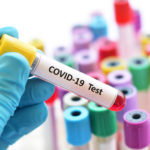
Lactic Acidosis in Liver Cirrhosis
Lactic Acidosis in Liver Cirrhosis
Love your liver this January with Biorex Diagnostics. Being the largest organ in the human body, the liver has a multitude of crucial functions essential for maintaining overall health. Despite its vital importance, it often doesn’t receive as much attention as other vital organs, like the lungs or heart 1. Acute and chronic hepatic insufficiency can lead to lactate accumulation and subsequently result in lactic acidosis 2.
Lactic Acid
Lactic acid, also known as lactate, emerges when cells metabolize carbohydrates for energy. It’s generated notably during intense physical efforts or instances when the body requires energy more rapidly than the available oxygen (anaerobic conditions), such as during vigorous exercise. Muscles produce lactic acid as a by-product of cellular metabolism in such situations. However, lactic acid isn’t solely generated in exercising muscles; any activity demanding increased oxygen usage can trigger its production. This encompasses various physical exertions like yard work or lifting heavy objects. The temporary increase in lactic acid levels typically poses no harm and is generally eliminated by the liver and kidneys3.
Lactic acid, or lactate, serves several roles within the body:
- Energy production: During times of intense physical activity or when oxygen availability is limited (anaerobic conditions), cells, particularly muscle cells, can produce energy quickly by breaking down glucose without the need for oxygen. This process, called anaerobic glycolysis, generates lactate as a by-product. Lactate can be used as a temporary energy source within the muscle cells themselves or transported to other tissues, like the heart or liver, where it can be converted back into glucose and used as fuel.
- Regulation of pH: Lactate also plays a role in maintaining the body’s acid-based balance. When produced in excess, it can contribute to changes in pH. The body has mechanisms to regulate this, such as converting lactate back into glucose in the liver, which helps stabilise pH levels.
- Metabolic fuel: Lactate produced in one tissue can be transported via the bloodstream to other tissues where it can serve as an energy source. For instance, the heart can use lactate as an energy substrate.
- Intermediary metabolite: Lactate is an intermediary metabolite in various metabolic pathways. It can be converted to pyruvate and then used in the Krebs cycle (citric acid cycle) to produce energy aerobically.
- Gluconeogenesis: After its production in tissues, lactic acid can be filtered out of the blood by the liver and kidneys. These organs play a crucial role in converting lactate back into glucose through gluconeogenesis. The newly synthesised glucose can then be stored or used by the body as an energy source when needed, helping to maintain blood sugar levels.
- Molecular Signalling: Lactic acid can act as a signalling molecule in the body. It functions as a signalling agent involved in various processes, including would healing and immune response. Lactic acid can attract immune cells to sites of tissue damage or infection, aiding in the healing process and fighting off infections. It serves as a kind of marker or signal for cells involved in the immune response.
In the past, lactate was viewed as a waste product or a factor contributing to fatigue during exercise. However, recent studies propose a more intricate function for lactate in metabolism and exercise physiology than previously understood. It serves as a crucial metabolic intermediary that multiple bodily tissues can utilize. Beyond being just a by-product of anaerobic metabolism, the multifaceted role of lactic acid showcases its importance as both an energy source and a signalling molecule involved in diverse physiological processes within the body. This includes its contribution to energy generation, metabolic control, and immune system response3.
Lactic Acidosis
Lactic acidosis arises when there’s an excessive buildup of lactic acid in the bloodstream, surpassing the body’s capacity to eliminate it. The liver and kidneys are pivotal in metabolizing and clearing surplus lactic acid from the system. However, if there’s an overwhelming production of lactic acid or if the liver or kidneys are impaired and incapable of effectively processing and removing the lactate, it can result in the accumulation of lactic acid in the blood. A moderate rise in blood lactate levels is termed hyperlactatemia, which might not necessarily cause substantial alterations in pH levels. Nonetheless, when the buildup of lactic acid reaches a point where it disrupts the body’s balance of acidity and alkalinity, leading to a decrease in blood pH (acidosis), it is then identified as lactic acidosis4.
Lactic acidosis can result from various conditions or factors, such as:
- Sepsis or infections: Severe infections can lead to a state of shock, impairing oxygen delivery to tissues and causing lactic acid build-up.
- Liver disease: Liver dysfunction or failure can hinder the breakdown and clearance of lactate, contributing to lactic acidosis.
- Metabolic disorders: Certain inherited metabolic disorders can disrupt the body’s ability to metabolise lactate, leading to its accumulation and lactic acidosis.
- Medications and toxins: Some medications or toxins can interfere with cellular metabolism, leading to increased lactate production and subsequent lactic acidosis.
- Hypoperfusion or shock: Conditions where there is decreased blood flow or oxygen delivery to tissues, such as in shock states or heart failure, can result in lactic acidosis.
The symptoms of lactic acidosis can range from mild to severe and might include: abdominal pain, confusion, lethargy, nausea, rapid breathing, vomiting, and in severe cases, shock or organ failure. Treatment involves addressing the underlying cause, providing supportive care, and correcting the acid-base imbalance. Prompt medical attention is crucial in managing lactic acidosis 4.
Liver Cirrhosis
Cirrhosis manifests as a condition marked by severe scarring of the liver tissue, which occurs due to prolonged liver injury from diverse sources such as autoimmune liver diseases, chronic alcohol misuse, non-alcoholic fatty liver disease (NAFLD), viral hepatitis, or other factors causing ongoing liver damage 5.
The liver possesses an extraordinary capacity for self-regeneration and repair. However, persistent liver injury or continual inflammation resulting from conditions like hepatitis or prolonged exposure to substances like alcohol triggers a healing process that leads to the development of scar tissue. This scarring, also referred to as fibrosis, progressively replaces healthy liver tissue, disrupting the liver’s structure and function 5.
As cirrhosis advances, the liver’s ability to carry out essential functions like nutrient processing, toxin filtration, protein synthesis, and regulation of metabolic processes becomes increasingly compromised. Advanced stages of cirrhosis can bring about complications such as portal hypertension (elevated pressure in the portal vein system), ascites (accumulation of fluid in the abdominal cavity), hepatic encephalopathy (brain dysfunction due to liver failure), and an increased susceptibility to liver cancer 5.
Regrettably, cirrhosis typically leads to irreversible damage. Nevertheless, prompt identification and management of the root cause, including treatment for viral hepatitis, addressing alcohol dependence, managing complications, and embracing lifestyle adjustments, can decelerate or halt the advancement of cirrhosis. In rare instances, particularly when cirrhosis is detected early and the underlying cause is effectively treated, there exists a possibility of restoring some degree of liver function or limiting further damage. Consistent monitoring, adherence to treatment regimens, and lifestyle changes are vital for individuals with cirrhosis to control the condition and prevent complications. Ultimately, advanced cirrhosis represents a severe and potentially life-threatening condition, necessitating continuous medical care and support 5.
Lactic Acidosis in Liver Cirrhosis
Multiple research studies have affirmed the direct link between lactic acidosis and liver cirrhosis.
- Acid-based status and its clinical implication in critically ill patients with cirrhosis, acute-on-chronic liver failure and without liver disease (2018) 6
A post hoc analysis of prospectively collected data of 178 critically ill patients with liver cirrhosis compared to 178 matched controls. The study found that hyperchloremic acidosis and hypoalbuminemic alkalosis coexist in the critically ill patients, including those with liver cirrhosis. The study found that in cirrhosis, particularly acute-on-chronic liver failure (ACLF), the net acidosis was caused by lactate and unmeasured ions (BEUMA). Lactate was linked to hepatic function and vasopressor use, whereas the unmeasured ions were strongly associated with acute kidney injury. The metabolic differences between cirrhosis and non-cirrhosis critically ill patients increased with the severity of the disease, resulting in pronounced academia in cirrhosis patients with ACLF. Lactate and BEUMA were identified as independent predictors of 28-day mortality in critically ill patients with liver cirrhosis and ACLF.
- Metabolic acidosis in critically ill patients with cirrhosis: Epidemiology and short-term mortality risk factors (2019) 7
A Chinese study prospectively evaluated 975 patients with cirrhosis to explore the epidemiology and risk factors of metabolic acidosis in critically ill patients with cirrhosis with a follow-up for at least 28 days. Of these 975 patients with liver cirrhosis, 506 had metabolic acidosis, including 275 patients who had decompensated metabolic acidosis at intensive care unit admission. The study concluded that critically ill patients with cirrhosis have a high mortality rate and poor prognosis due to the high prevalence of metabolic acidosis. It was found that lactic acidosis was the worst prognosis of all the different types of metabolic acidosis.
- Liver cirrhosis affects serum lactate level measurement while assessing disease severity in patients with sepsis (2021) 8
A Chinese study retrospectively evaluated 12,281 cases of infection, with initial serum blood lactate drawn during January 2007-December 2013 to determine the predictive ability of serum lactate in patients with liver cirrhosis and sepsis. The study concluded that serum lactate levels can be used to predict the severity of sepsis in patients with liver cirrhosis.
- Serum lactate levels in cirrhosis and non-cirrhosis patients with septic shock (2022) 9
A retrospective cohort study conducted at a referral, university-affiliated medical centre in Thailand between 2012 and 2018 who satisfied the septic shock diagnostic criteria of the Surviving Sepsis Campaign: 2012. 777 patients were enrolled of which 91 had previously been diagnosed with cirrhosis with lactate levels reviewed on arrival and at 6 hours. The study concluded that the initial lactate level and lactate at 6 hours were significantly higher in cirrhosis patients than in non-cirrhosis patients.
How Biorex Can Help
At Biorex Diagnostics, we offer a few lactate assays.
| Description | Cat Code | Kit Size | Category |
| Lactate (Lyo.) | BXC0621A | R1: 1x105ml; R2: 16x6ml; R4: 1x5ml | Clinical Chemistry Reagent |
| Lactate (Monoliquid) Enzymatic (Colorimetric | BXC0622A | R1: 2x50ml; R2: 1x5ml | Clinical Chemistry Reagent |
| Lactate Dehydrogenase P-L (L.S) | BXC0242A | R1: 5x20ml; R2: 1x20ml | Clinical Chemistry Reagent |
| Lactate Dehydrogenase L-P (L.S) | BXC0243A | R1: 5x20ml; R2: 1x20ml | Clinical Chemistry Reagent |
| Lactate | HIT0621B | R1: 1 x 100ml R2: 16 X 6ml | System Reagents |
| Lactate (Mono) | HIT0622A | R1: 5 x 20ml | System Reagents |
| Lactate Dehydrogenase P-L | HIT0242A | R1: 12 x 20ml R2: 3 x 20ml | System Reagents |
| Lactate Dehydrogenase P-L | HIT0242C | R1: 2 x 20ml R2: 1 x 8ml | System Reagents |
| Lactate Dehydrogenase L-P | HIT0243A | R1: 12 x 20ml R2: 3 x 20ml | System Reagents |
| Lactate Pyruvate | HIT0243C | R1: 2 x 20ml R2: 1 x 8ml | System Reagents |
| Lactate (Mono) | OLY0622B | R1: 2 x 30ml | System Reagents |
| Lactate (Mono) | BXCF622A | R1: 4 x 20.5ml | System Reagents |
Biorex Diagnostics Hepatic Panel
| Description | Category |
| Alanine Aminotransferase (ALT) | Clinical Chemistry Reagent |
| Alanine Aminotransferase (ALT) | System Reagents |
| Aspartate Aminotransferase (AST) | Clinical Chemistry Reagent |
| Aspartate Aminotransferase (AST) | System Reagents |
| Albumin | Clinical Chemistry Reagent |
| Albumin | System Reagents |
| Ammonia | Clinical Chemistry Reagent |
| Ammonia | System Reagents |
| Ammonia | Controls & Calibrators |
| Alcohol/Ammonia/Carbonate | Controls & Calibrators |
| Bile Acids | Clinical Chemistry Reagent |
| Bile Acids | System Reagents |
| Bilirubin | Clinical Chemistry Reagent |
| Bilirubin | System Reagents |
| Bilirubin | Controls & Calibrators |
| Hepatitis A | ELISA |
| Hepatitis B | ELISA |
| Hepatitis C | ELISA |
| Hepatitis D | ELISA |
| Hepatitis E | ELISA |
| Urine Strips | Urinalysis |
| Blood Alcohol | Clinical Chemistry Reagent |
| Blood Alcohol | System Reagents |
| Blood Alcohol | Controls & Calibrators |
| Gamma-Glutamyltransferase (GGT) | Clinical Chemistry Reagent |
| Gamma-Glutamyltransferase (GGT) | System Reagents |
| PT High Sensitivity | Haemostasis |
| PT Low Sensitivity | Haemostasis |
| Total Protein | Clinical Chemistry Reagent |
| Total Protein | System Reagents |
References
- British Liver Trust. Love Your Liver awareness month. https://britishlivertrust.org.uk/love-your-liver-month/ (accessed 14 December 2023).
- Cheng CY, Kung CT, Wu KH, Chen FC, Cheng HH, et al. Liver cirrhosis affects serum lactate level measurement while assessing disease severity in patients with sepsis. European Journal of Gastroenterol Hepatol 2021; 33(9): . https://www.ncbi.nlm.nih.gov/pmc/articles/PMC8322043/ (accessed 18 December 2023).
- Cleveland Clinic. What is lactic acid?. https://my.clevelandclinic.org/health/body/24521-lactic-acid (accessed 18 December 2023).
- Cleveland Clinic. Lactic Acidosis. https://my.clevelandclinic.org/health/diseases/25066-lactic-acidosis (accessed 18 December 2023).
- Mayo Clinic. https://www.mayoclinic.org/diseases-conditions/cirrhosis/symptoms-causes/syc-20351487 (accessed 18 December 2023).
- Drolz A, Horvatits T, Roedl K, Rutter K, Brunner R, et al. Acid–base status and its clinical implications in critically ill patients with cirrhosis, acute-on-chronic liver failure and without liver disease. Annals of Intensive Care 2018; 48(8): . https://annalsofintensivecare.springeropen.com/articles/10.1186/s13613-018-0391-9 (accessed 18 September 2023).
- Gao F, Lin MT, Yang XY, Cai MX, Nan H, et al. Metabolic acidosis in critically ill patients with cirrhosis: Epidemiology and short-term mortality risk factors. Turkish Journal of Gastroenterology 2019; 30(10): . https://www.ncbi.nlm.nih.gov/pmc/articles/PMC6812953/ (accessed 18 December 2023).
- Cheng CY, Kung CT, Wu KH, Chen FC, Cheng HH, et al. Liver cirrhosis affects serum lactate level measurement while assessing disease severity in patients with sepsis. European Journal of Gastroenterology and Hepatology 2021; 33(9): . https://www.ncbi.nlm.nih.gov/pmc/articles/PMC8322043/ (accessed 18 December 2023). Tongyoo S, Sutthipool K, Viarasilpa T, Permpikul C. Serum lactate levels in cirrhosis and non-cirrhosis patients with septic shock. Acute and Critical Care 2022; 37(1): . chrome-extension://efaidnbmnnnibpcajpcglclefindmkaj/https://www.accjournal.org/upload/pdf/acc-2021-00332.pdf (accessed 18 December 2023).







